Why you can trust Tom's Hardware
Comparison Products
We compare the 1TB Inland Platinum External SSD to the Samsung T7 Shield and T7 Touch, the WD Black P50 and My Passport SSD, the Crucial X8, the SanDisk Extreme v2, and the Kingston XS2000. All of these are at 1TB of capacity. We already mentioned that the T7 and XS2000 are interesting drives to compare as they let us see what Phison can do with an integrated controller design.
Game Scene Loading - Final Fantasy XIV
Final Fantasy XIV Shadowbringers is a free real-world game benchmark that easily and accurately compares game load times without the inaccuracy of using a stopwatch.
The Platinum External comes in dead last when it comes to FFXIV loading times. This isn't surprising given the two-channel controller design and QLC flash. The XS2000 with SMI’s four-channel design and TLC flash takes first place.
Trace Testing – PCMark 10 Storage Benchmark
PCMark 10 is a trace-based benchmark that uses a wide-ranging set of real-world traces from popular applications and everyday tasks to measure the performance of storage devices.

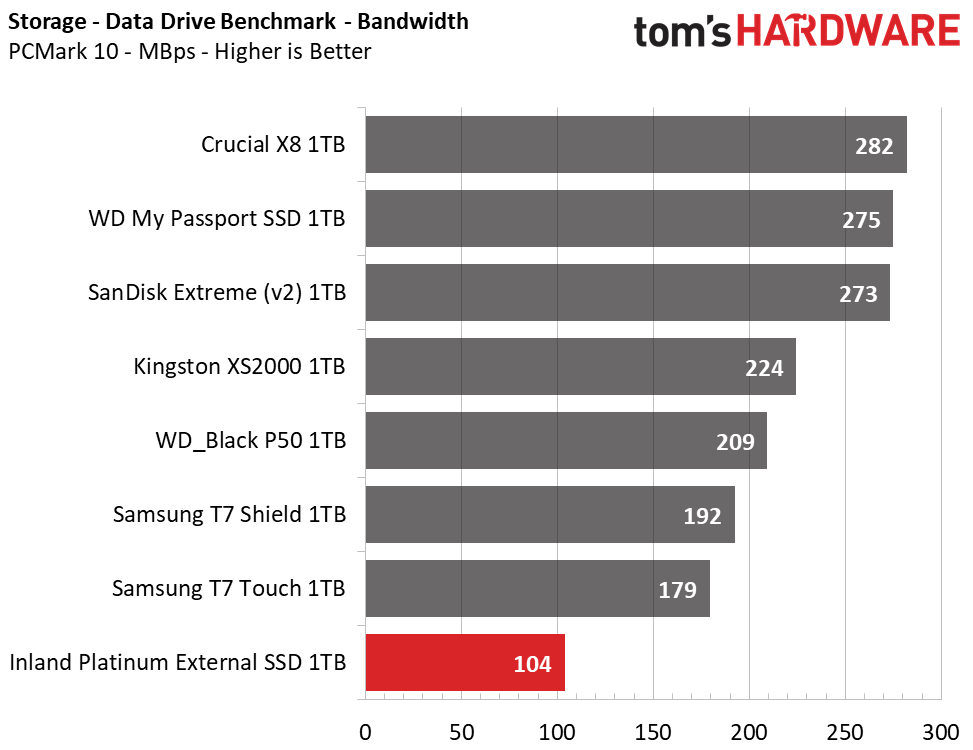

In general, performance is pretty poor here. The Platinum External again lands in last place and can’t even catch the 10 Gbps Samsung T7 drives. This is a limitation of the internal hardware.
Transfer Rates – DiskBench
We use the DiskBench storage benchmarking tool to test file transfer performance with a custom, 50GB dataset. We copy 31,227 files of various types, such as pictures, PDFs, and videos to a new folder and then follow-up with a reading test of a newly-written 6.5GB zip file.
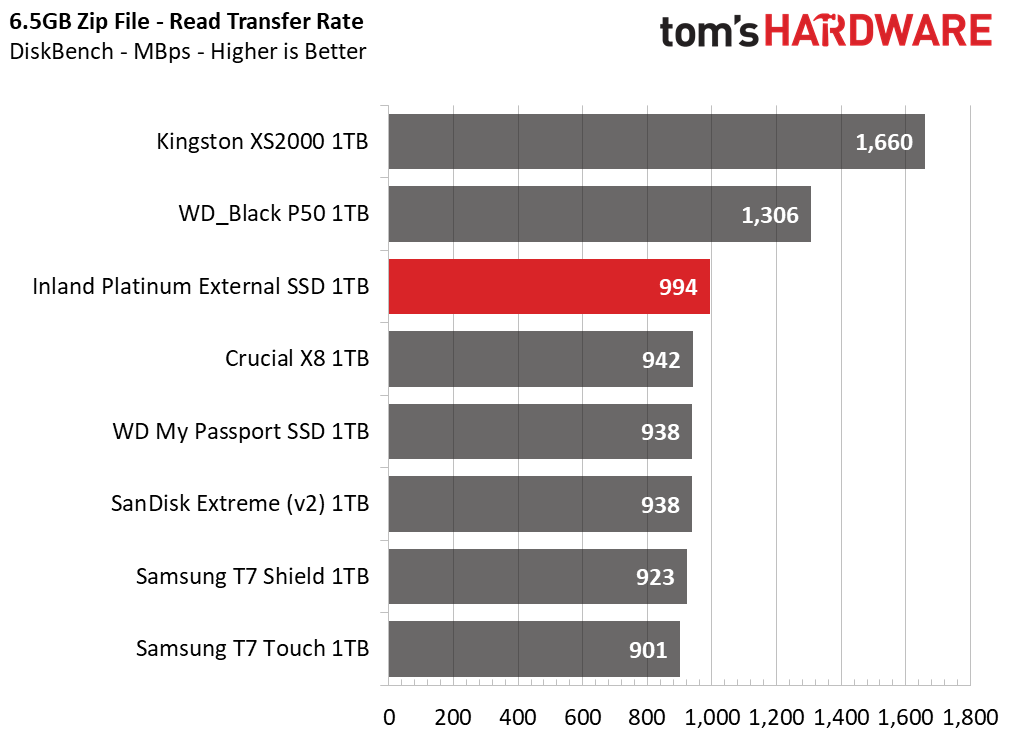
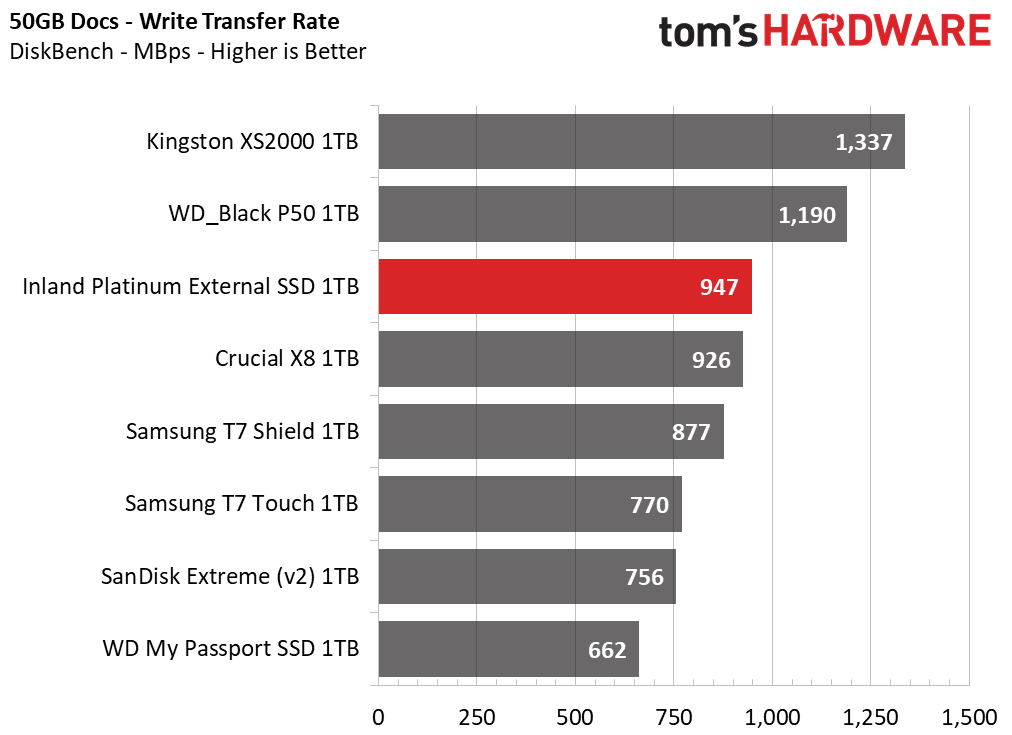

This bandwidth-heavy test essentially measures the sequential interface speed. As such, the Platinum External falls in line with the other 10 Gbps (USB 3.2 Gen 2x1) portable SSDs.
Get Tom's Hardware's best news and in-depth reviews, straight to your inbox.
Synthetic Testing - CrystalDiskMark
CrystalDiskMark (CDM) is a free and easy-to-use storage benchmarking tool that SSD vendors commonly use to assign performance specifications to their products. It gives us insight into how each device handles different file sizes.









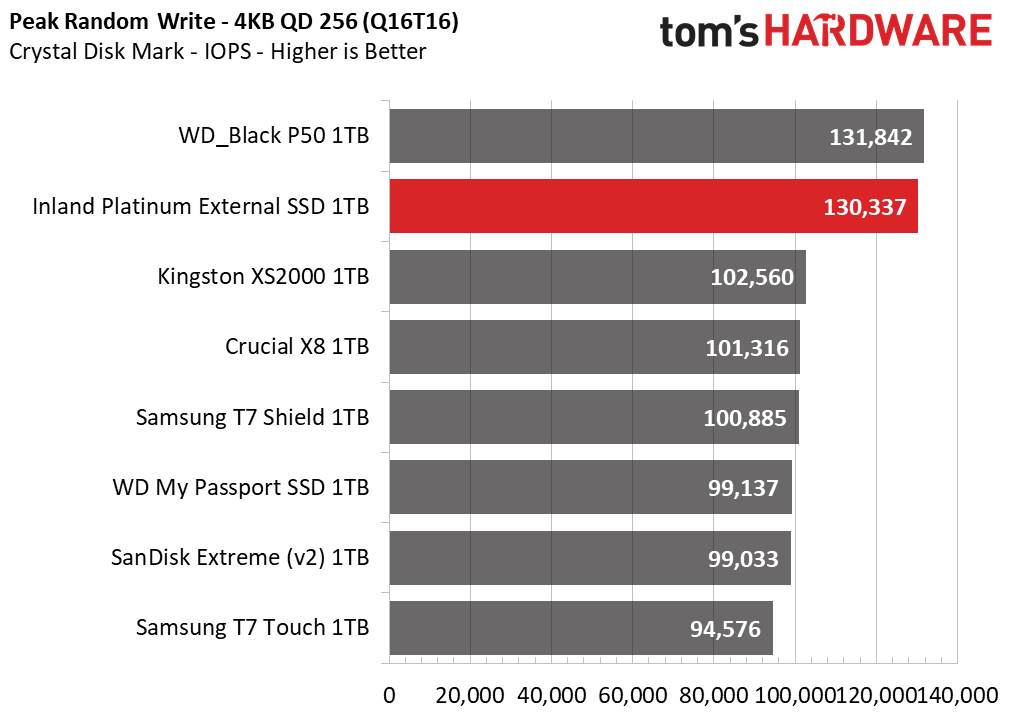
CrystalDiskMark’s sequential tests perform as expected. Similar to the DiskBench tests above, the interface speed limits the drives. Inland could release a 20 Gbps variant of this drive, if it so desired, to compete with the products using SMI’s SM2320 hybrid controller, albeit with half the channels.
The random I/O results are more interesting, particularly in regard to write performance. While neither the Platinum External nor XS2000 do well with high queue depth random reads, the former performs adequately at queue depth 1. That does tend to be an important metric for general use. Moreover, both drives have strong queue depth 1 random write performance. This is due to a lower base latency as the controllers do not have to go through a separate bridge chip.
Considering these controllers are also more power-efficient, this is of interest to those who may need to copy a lot of small files on the go. Generally, the SLC caches are sufficiently large on these types of drives and can absorb that type of incoming workload without issue.
Sustained Write Performance, Cache Recovery, and Temperature
Official write specifications are only part of the performance picture. Most SSDs implement a write cache, which is a fast area of (usually) pseudo-SLC programmed flash that absorbs incoming data. Sustained write speeds can suffer tremendously once the workload spills outside of the cache and into the "native" TLC or QLC flash. We use Iometer to hammer the SSD with sequential writes for 15 minutes to measure both the size of the write cache and performance after the cache is saturated. We also monitor cache recovery via multiple idle rounds.



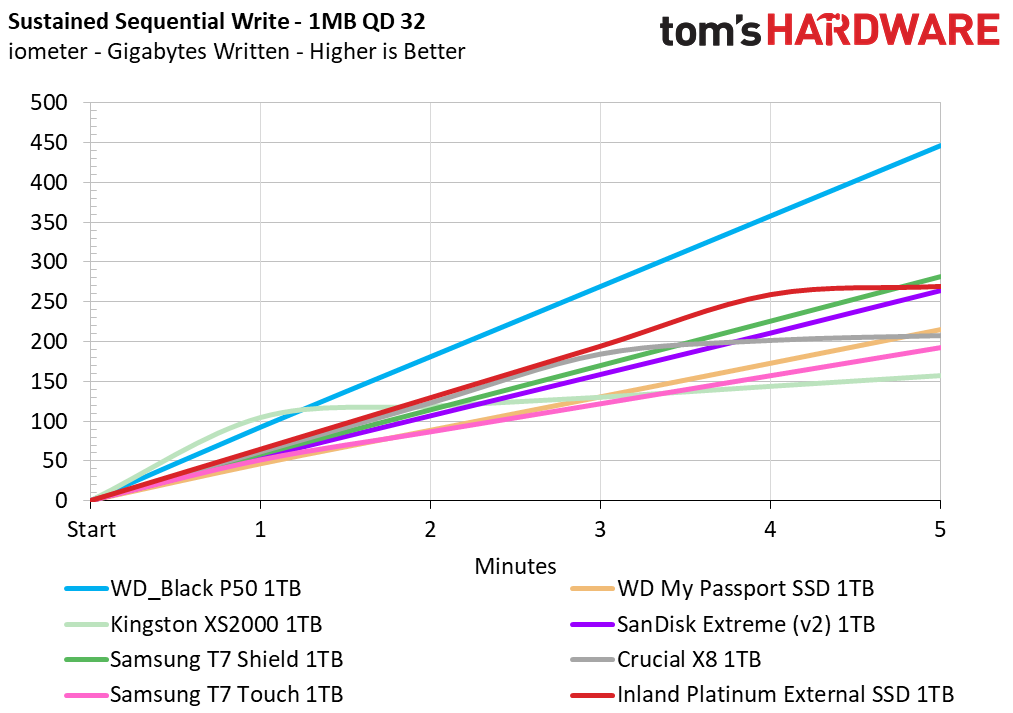

The Inland Platinum writes at around 1.08 GBps for almost 250 seconds, suggesting an SLC cache size of up to 266GB. All of this drive’s native flash is likely being used in pSLC mode - meaning a quarter of the total capacity. After the SLC runs out, the sustained write performance goes as low as 50 MBps or below. This is not unexpected with a 2-channel design utilizing QLC given such a large, dynamic SLC cache. This drive is clearly better designed for reads and bursty write workloads rather than sustained writes.
The Samsung T7 Shield was designed for sustained write performance, clearly shown here. The XS2000, on the other hand, has a faster interface and, therefore, a higher maximum SLC write speed, which is followed by very poor TLC write speeds. These embedded, portable SSD designs naturally have this type of performance. It is a weakness but also a reasonable compromise if the user never sees the edge cases in normal use.
SLC cache recovery was relatively rapid. Phison states that the U17 controller has a built-in thermal sensor with 70C being the upper boundary during operation. After sustained writes, we saw a high temperature of around 66C with the surface hitting 38C, both within reason. This drive could use better cooling, though, perhaps with thermal padding and a more thermally-conductive surface material.
Samsung designed the T7 Shield to remain within specification even in hotter climates, whereas this drive may have more serious concerns in such an environment. That being said, it’s unlikely to be used for sustained writes where the temperature becomes a problem, and once it exceeds the SLC cache, it will be too slow to throttle anyway. Therefore, adding thermal padding is more of an option for DIY users who want extra security.
Test Bench and Testing Notes
| CPU | Intel Core i9-11900K |
| Motherboard | ASRock Z590 Taichi |
| Memory | 2x8GB Kingston HyperX Predator DDR4 5333 |
| Graphics | Intel UHD Graphics 750 |
| CPU Cooling | Alphacool Eissturm Hurricane Copper 45 3x140mm |
| Case | Streacom BC1 Open Benchtable |
| Power Supply | Corsair SF750 Platinum |
| OS Storage | WD_Black SN850 2TB |
| Operating System | Windows 10 Pro 64-bit 20H2 |
We use a Rocket Lake platform with most background applications such as indexing, windows updates, and anti-virus disabled in the OS to reduce run-to-run variability. Each SSD is prefilled to 50% capacity and tested as a secondary device. Unless noted, we use active cooling for all SSDs.
Conclusion
Perhaps it would be better to see this drive as kind of a chunky USB flash drive. In fact, there are flash drive-sized SSDs on the market, including some that use the same controller. Some USB flash drive controllers are also two-channel, of course. The U18 simply offers better peak performance and is paired with better-quality flash than what you find on USB flash drives. That makes this even more of a niche product, but one that can find limited use - perhaps as part of a wider toolbox for on-the-go users.
The first thing we have to mention is errors in this drive’s product listing. The sequential read and write metrics do not seem correct, even if we had no trouble pushing the limits of 10 Gbps for both during testing; they’re listed differently on Micro Center’s site and Amazon. Further, and more seriously, Micro Center lists this drive as coming with TLC flash. This is more common than some users might realize — it’s not uncommon to find drives that say they have TLC or DRAM when the internal hardware varies.
This is disappointing coming from Inland. The representative was quick to confirm our QLC suspicions, and the use of QLC is not generally detrimental given this drive’s intended use. The overall design is, at least, conducive to using QLC at 1TB. This drive is especially small, power-efficient, and cheaper, which makes QLC a fair compromise, although buyers may not be happy about the NAND mixup.
That said, this is a bit of a niche product. It’s perfect for someone who is doing mostly reads with some bursty writes. Or someone who needs something small and efficient. This is particularly true for laptop and mobile users. Videographers will want to step up to the T7 Shield for ruggedness and sustained performance, and those wanting higher performance need a USB 3.2 Gen 2x2 or Thunderbolt portable SSD instead. This drive is minimalist and cannot be shucked, so be aware of what you’re getting with it.
MORE: Best SSDs
MORE: How We Test HDDs And SSDs
MORE: All SSD Content

Shane Downing is a Freelance Reviewer for Tom’s Hardware US, covering consumer storage hardware.
-
derekullo Is write endurance not applicable because it's unlimited or because its 2 Terabytes ?Reply
